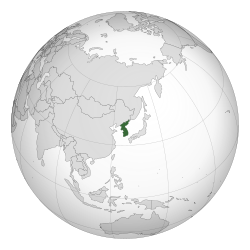
Back جمهورية كوريا الشعبية Arabic Народна република Корея Bulgarian República Popular de Corea Catalan Folkerepublikken Korea Danish Volksrepublik Korea German Λαϊκή Δημοκρατία της Κορέας Greek República Popular de Corea Spanish جمهوری خلق کره Persian Korean kansantasavalta Finnish République populaire de Corée French
People's Republic of Korea | |||||||||||||
|---|---|---|---|---|---|---|---|---|---|---|---|---|---|
| 1945–1946 | |||||||||||||
| Motto: 자주독립국가 Chaju dongnip kukka "Self-reliant and independent state" | |||||||||||||
| Anthem: 애국가 Aegukka "The Patriotic Song" | |||||||||||||
 | |||||||||||||
| Capital and largest city | Seoul | ||||||||||||
| Common languages | Korean | ||||||||||||
| Government | Democratic republic under a provisional government | ||||||||||||
| Chairman of the National People's Representative Conference | |||||||||||||
• 1945–1946 | Lyuh Woon-hyung | ||||||||||||
| Historical era | Cold War | ||||||||||||
| 15 August 1945 | |||||||||||||
• Soviet forces stationed in Pyongyang | 24 August 1945 | ||||||||||||
• American forces stationed in Seoul | 9 September 1945 | ||||||||||||
• PRK dissolved in the South | 12 December 1945 | ||||||||||||
• Committees co-opted in the North | 8 February 1946 | ||||||||||||
| Currency | Korean won | ||||||||||||
| |||||||||||||
| Today part of | North Korea South Korea | ||||||||||||
| People's Republic of Korea | |
| Hangul | 조선인민공화국 |
|---|---|
| Hanja | 朝鮮人民共和國 |
| Revised Romanization | Joseon Inmin Gonghwaguk |
| McCune–Reischauer | Chosŏn Inmin Konghwaguk |
The People's Republic of Korea (PRK; Korean: 조선인민공화국) was a short-lived provisional government that was organized at the time of the surrender of the Empire of Japan at the end of World War II. It was proclaimed on 6 September 1945, as Korea was being divided into two occupation zones, with the Soviet Union occupying the north and the United States occupying the south. Based on a network of people's committees, it presented a program of democratization of society (민주주의) and the economy (사회주의).
In the south, the US military government declared the PRK to be illegitimate on 12 December 1945. In the north, the Soviet authorities took over the PRK by installing pro-Soviet Korean communists such as Kim Il-sung into positions of power and incorporated it into the political structure of the emerging Democratic People's Republic of Korea (North Korea).[1][2]
- ^ Cumings, Bruce (1981). The Origins of the Korean War, Liberation and the Emergence of Separate Regimes, 1945–1947. Princeton University Press. pp. 196–197, 392–393, 408.
- ^ Armstrong, Charles (2004). The North Korean Revolution, 1945–1950 (1st ed.). Cornell University Press. p. 54.

